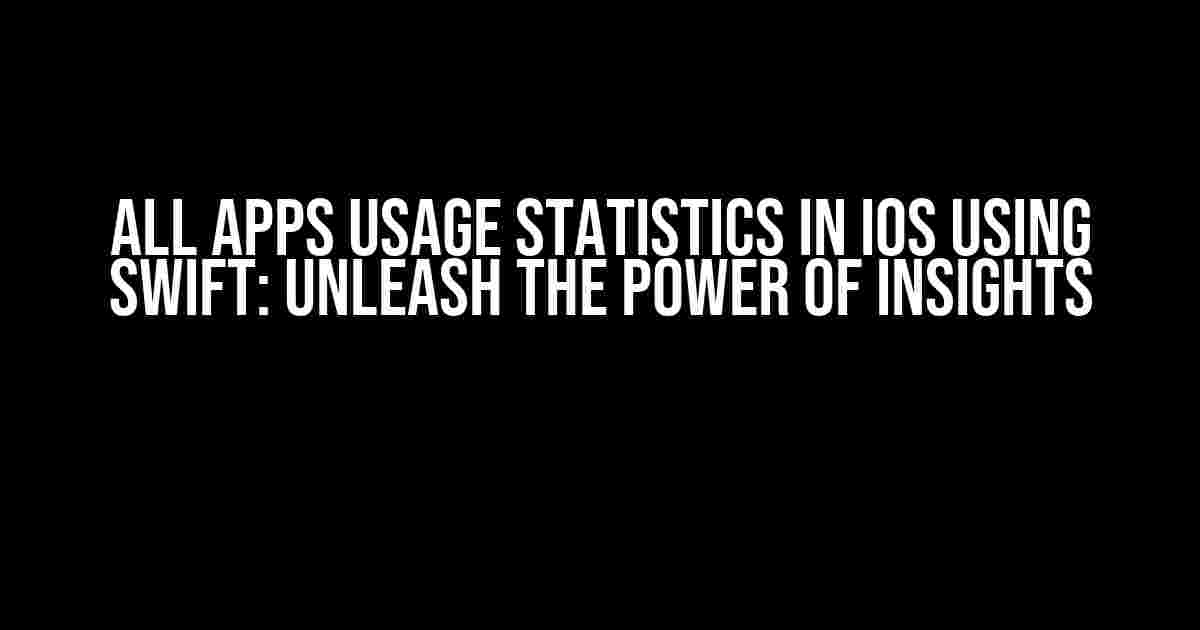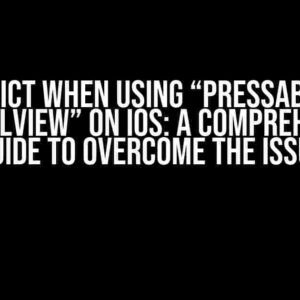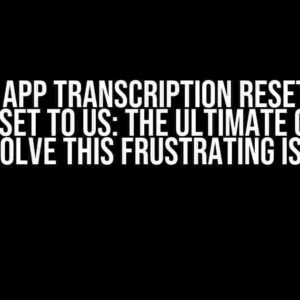Welcome to the world of iOS development, where understanding user behavior is key to creating engaging and successful apps! In this comprehensive guide, we’ll delve into the realm of All Apps usage statistics in iOS using Swift, providing you with the knowledge and tools to unlock valuable insights and take your app development to the next level.
Why App Usage Statistics Matter
Before we dive into the nitty-gritty, let’s understand why app usage statistics are crucial for your iOS app’s success:
- Identify User Behavior Patterns: By analyzing app usage, you can pinpoint trends, habits, and areas of improvement to enhance the overall user experience.
- Optimize Performance and Resource Allocation: Insights into app usage help you allocate resources efficiently, reducing crashes, and improving load times.
- Inform Data-Driven Decisions: With accurate usage statistics, you can make informed decisions about feature development, marketing strategies, and overall business goals.
Getting Started with All Apps Usage Statistics in iOS
To collect All Apps usage statistics in iOS, we’ll utilize the following frameworks and tools:
- Swift: Our programming language of choice for building iOS apps.
- Core Telephony: A framework that provides information about the device’s telephony capabilities and usage.
- UIDevice: A class that provides information about the device, including its type, OS version, and more.
Step 1: Set up Your Project
Create a new Swift project in Xcode, and add the following frameworks to your project:
Step 2: Collect App Usage Data
We’ll use the `CTTelephonyNetworkInfo` class to collect information about the device’s telephony capabilities and usage. Add the following code to your view controller:
let telephonyInfo = CTTelephonyNetworkInfo()
let carrierName = telephonyInfo.subscriberCellularProvider?.carrierName
let countryCode = telephonyInfo.subscriberCellularProvider?.isoCountryCode
print("Carrier Name: \(carrierName ?? "")")
print("Country Code: \(countryCode ?? "")")This code retrieves the carrier name and country code, which can help you identify usage patterns and trends.
Step 3: Track App Launches and Sessions
To track app launches and sessions, we’ll utilize the `UIDevice` class and the `UIApplication` delegate methods. Add the following code to your app delegate:
func application(_ application: UIApplication, didFinishLaunchingWithOptions launchOptions: [UIApplication.LaunchOptionsKey: Any]?) -> Bool {
// Track app launch
print("App launched")
return true
}
func applicationWillEnterForeground(_ application: UIApplication) {
// Track app session start
print("App entered foreground")
}
func applicationDidEnterBackground(_ application: UIApplication) {
// Track app session end
print("App entered background")
}This code tracks app launches and sessions, providing valuable insights into user behavior.
Step 4: Analyze and Visualize App Usage Data
To analyze and visualize the collected data, you can use a variety of tools and frameworks, such as:
- Google Analytics: A popular analytics platform for tracking app usage and behavior.
- Core Data: A framework for storing and managing data in your app.
- D3.js: A JavaScript library for creating interactive, web-based data visualizations.
By integrating these tools and frameworks, you can create a comprehensive analytics system that provides actionable insights into your app’s usage and performance.
Common Use Cases for All Apps Usage Statistics in iOS
The collected app usage data can be applied to a wide range of use cases, including:
- Personalized User Experiences: Tailor your app’s content and features to individual users based on their behavior and preferences.
- Performance Optimization: Identify bottlenecks and areas for improvement to enhance your app’s overall performance and stability.
- Targeted Marketing Campaigns: Create targeted marketing campaigns based on user behavior and demographics.
- A/B Testing and Experimentation: Use app usage data to inform A/B testing and experimentation, driving iterative improvement and growth.
Best Practices for App Usage Statistics in iOS
To ensure the accuracy and reliability of your app usage statistics, follow these best practices:
- Collect Data in a Non-Intrusive Manner: Avoid collecting sensitive user data or disrupting the user experience.
- Adhere to Apple’s Guidelines and Policies: Comply with Apple’s guidelines and policies for collecting and storing user data.
- Use Secure Data Storage and Transmission: Implement secure data storage and transmission protocols to protect user data.
- Provide Transparency and User Control: Offer users transparency into data collection and provide controls for opting-out or managing their data.
Conclusion
In this comprehensive guide, we’ve explored the world of All Apps usage statistics in iOS using Swift, covering the importance of app usage data, setting up your project, collecting app usage data, tracking app launches and sessions, analyzing and visualizing data, and common use cases and best practices.
By mastering the art of collecting and analyzing app usage statistics, you’ll be well-equipped to create engaging, user-friendly, and high-performing iOS apps that drive success and growth. So, what are you waiting for? Dive into the world of app usage statistics and unlock the full potential of your iOS app!
| Framework/Tool | Description |
|---|---|
| Core Telephony | Provides information about the device’s telephony capabilities and usage. |
| UIDevice | Provides information about the device, including its type, OS version, and more. |
| Google Analytics | A popular analytics platform for tracking app usage and behavior. |
| Core Data | A framework for storing and managing data in your app. |
| D3.js | A JavaScript library for creating interactive, web-based data visualizations. |
Happy coding, and remember to keep tracking those app usage statistics!
Here are 5 Questions and Answers about “All Apps usage statistics in iOS using swift” with a creative voice and tone:
Frequently Asked Question
Got questions about tracking app usage statistics in iOS using Swift? We’ve got the answers!
Q1: How can I track app usage statistics in iOS using Swift?
You can use the `ProcessEvent` class in Swift to track app usage statistics. This class provides information about the current process, including the CPU usage and memory usage of your app. You can also use third-party libraries like `AppUsageStats` to get detailed usage statistics.
Q2: Can I get a list of all installed apps on an iOS device using Swift?
Unfortunately, no! Apple’s privacy policies restrict access to the list of installed apps on an iOS device. However, you can use the `UIApplication.shared.canOpenURL(_:)` method to check if a specific app is installed on the device.
Q3: How can I track screen time and app usage duration in iOS using Swift?
You can use the `UIScreen` class to track screen time and app usage duration. Specifically, you can use the `UIScreen mainScreen` property to get the current screen state and the `(applicationDidBecomeActive` delegate method to track when your app becomes active.
Q4: Are there any iOS APIs that provide app usage statistics, such as time spent in each app?
Yes! iOS provides the `-screenTimeUsage` API, which allows you to track app usage statistics, including time spent in each app. You can access this API using the `SKScreenTime` framework.
Q5: Can I use Swift to track app usage statistics across all iOS devices?
Unfortunately, no! Apple’s privacy policies restrict access to app usage statistics across all iOS devices. You can only track app usage statistics on the device your app is running on.
Let me know if you need any changes!



